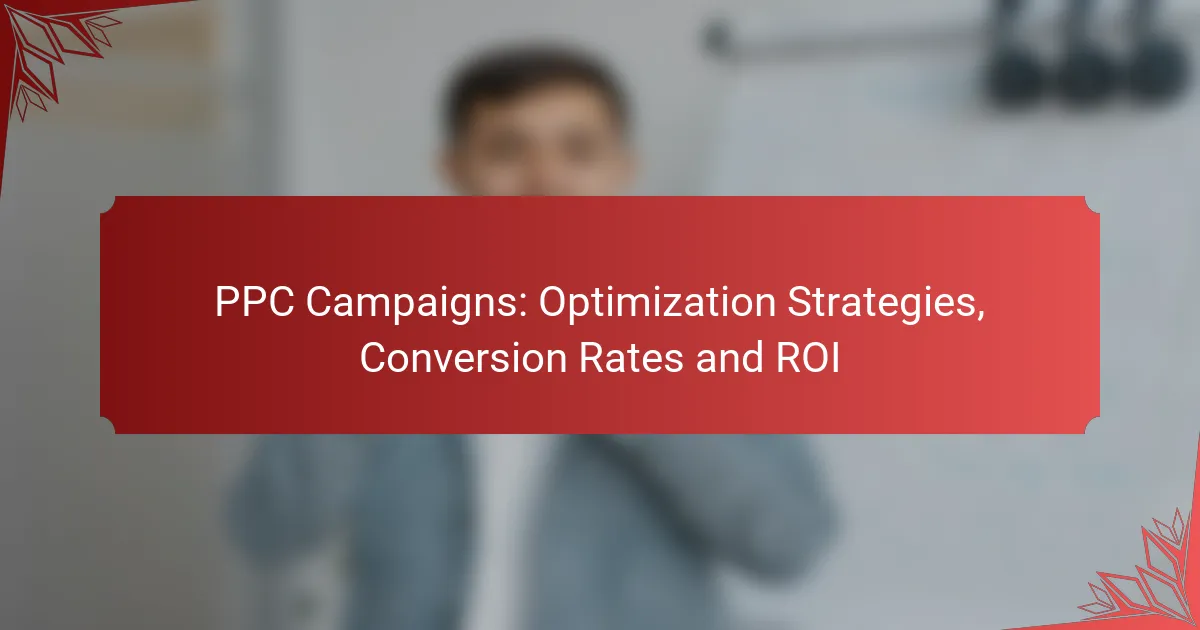Optimizing PPC campaigns is essential for maximizing return on investment (ROI) and improving conversion rates. By refining keyword targeting, enhancing ad copy, and improving landing pages, advertisers can lower costs while boosting campaign effectiveness. Key metrics such as conversion rate, cost per acquisition, and return on ad spend provide valuable insights for ongoing optimization efforts.
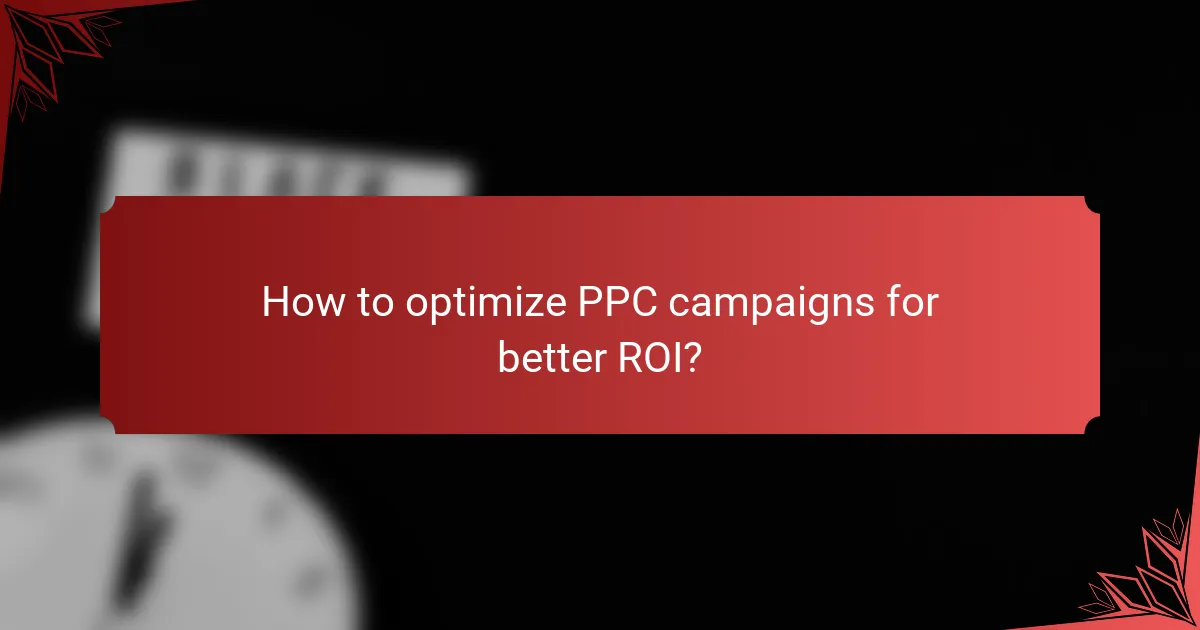
How to optimize PPC campaigns for better ROI?
To optimize PPC campaigns for better ROI, focus on refining your keyword targeting, enhancing ad copy, and improving landing pages. These strategies help increase conversion rates and lower costs, ultimately boosting your return on investment.
Keyword targeting strategies
Effective keyword targeting is crucial for reaching the right audience. Start by conducting thorough keyword research to identify high-performing terms relevant to your business. Utilize tools like Google Keyword Planner to find keywords with a balance of search volume and competition.
Consider using long-tail keywords, which are often less competitive and can lead to higher conversion rates. For example, instead of targeting “shoes,” try “women’s running shoes size 8.” This specificity can attract more qualified leads.
Ad copy enhancements
Enhancing your ad copy can significantly impact click-through rates and conversions. Use compelling headlines and clear calls to action that resonate with your target audience. Highlight unique selling points or promotions to grab attention.
A/B testing different versions of your ad copy can help determine what works best. For instance, test variations in wording, offers, or even the display URL to see which combination yields the highest engagement.
Landing page optimization
Optimizing landing pages is essential for converting clicks into customers. Ensure that your landing page aligns with the ad’s message and provides a seamless user experience. Fast loading times and mobile responsiveness are critical factors.
Include clear calls to action and minimize distractions on the page. For example, if your ad promotes a discount, prominently display the offer and make it easy for users to take action, such as filling out a form or making a purchase.
Bid management techniques
Effective bid management can enhance your PPC campaign’s performance. Utilize automated bidding strategies offered by platforms like Google Ads to optimize bids based on your goals, such as maximizing conversions or targeting a specific return on ad spend.
Regularly review and adjust your bids based on performance data. For instance, increase bids for high-performing keywords while reducing bids for those that underperform. This approach helps allocate your budget more effectively.
Utilizing negative keywords
Incorporating negative keywords into your PPC campaigns can prevent your ads from showing for irrelevant searches, saving budget and improving ROI. Identify terms that do not align with your offerings and add them as negative keywords to filter out unwanted traffic.
For example, if you sell premium products, you might want to add “cheap” as a negative keyword to avoid clicks from users looking for lower-priced options. Regularly update your negative keyword list based on search term reports to refine targeting further.
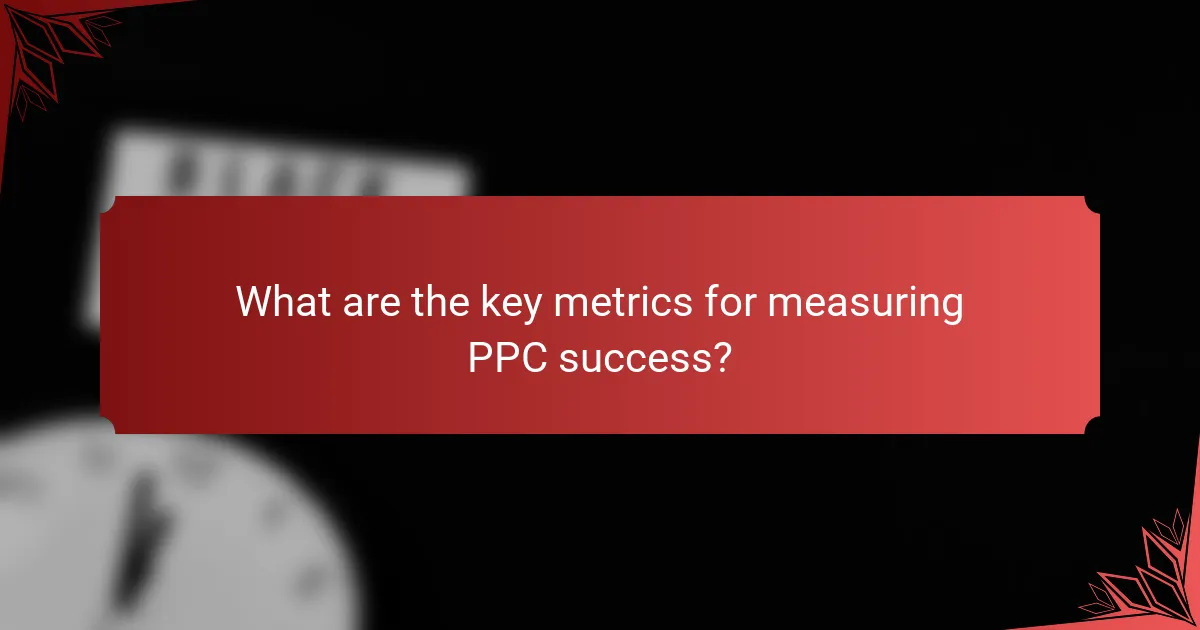
What are the key metrics for measuring PPC success?
The key metrics for measuring PPC success include conversion rate, cost per acquisition (CPA), and return on ad spend (ROAS). These metrics provide insights into the effectiveness and profitability of your campaigns, helping you make informed decisions for optimization.
Conversion rate analysis
Conversion rate analysis focuses on the percentage of users who complete a desired action after clicking on your ad. A higher conversion rate indicates that your ads are effectively targeting the right audience and compelling them to act.
To calculate conversion rate, divide the number of conversions by the total number of clicks and multiply by 100. For example, if you received 100 clicks and 5 conversions, your conversion rate would be 5%. Aim for a conversion rate that aligns with industry benchmarks, which can vary widely but often fall between 2% and 5% for many sectors.
Regularly analyze your conversion rates to identify trends and areas for improvement. Test different ad copy, landing pages, and targeting options to enhance performance.
Cost per acquisition (CPA)
Cost per acquisition (CPA) measures the total cost of acquiring a customer through your PPC campaigns. This metric helps you understand how much you are spending to gain each customer, which is crucial for budgeting and profitability analysis.
To calculate CPA, divide your total ad spend by the number of conversions. For instance, if you spent $500 on ads and gained 10 customers, your CPA would be $50. Generally, a lower CPA is preferable, as it indicates more efficient spending.
Monitor your CPA closely and compare it to your customer lifetime value (CLV). If your CPA exceeds your CLV, consider optimizing your campaigns to reduce costs or increase conversion rates.
Return on ad spend (ROAS)
Return on ad spend (ROAS) measures the revenue generated for every dollar spent on advertising. This metric is essential for assessing the overall effectiveness of your PPC campaigns in driving sales.
To calculate ROAS, divide the revenue generated from your ads by the total ad spend. For example, if your ads generated $2,000 in revenue and you spent $500, your ROAS would be 4:1, meaning you earned $4 for every $1 spent. A ROAS of 3:1 or higher is often considered a good benchmark.
Regularly evaluate your ROAS to ensure your campaigns are profitable. If your ROAS is below your target, consider adjusting your bidding strategy, refining your audience targeting, or improving your ad creatives to enhance performance.

How to improve conversion rates in PPC campaigns?
Improving conversion rates in PPC campaigns involves optimizing various elements of your ads and landing pages to encourage user actions. Key strategies include A/B testing, enhancing user experience, and implementing remarketing tactics.
A/B testing ad variations
A/B testing allows you to compare different versions of your ads to determine which performs better in terms of conversion rates. By changing one element at a time, such as headlines, call-to-action buttons, or images, you can identify what resonates most with your audience.
Start by selecting a specific metric to measure, like click-through rate or conversion rate. Run tests for a sufficient duration to gather meaningful data, ideally a few weeks, depending on your traffic volume. Analyze the results and implement the winning variation to maximize effectiveness.
Enhancing user experience
Enhancing user experience on your landing pages is crucial for improving conversion rates. Ensure that your pages load quickly, are mobile-friendly, and have a clear layout that guides users toward the desired action.
Consider using concise and compelling copy, along with engaging visuals that align with your ad messaging. A streamlined checkout process can also significantly reduce drop-off rates, so minimize the number of steps required to complete a purchase or sign-up.
Implementing remarketing strategies
Remarketing strategies target users who have previously interacted with your ads or website, reminding them of your offerings and encouraging them to return. This approach can significantly boost conversion rates as it focuses on an audience already familiar with your brand.
Utilize platforms like Google Ads or Facebook Ads to create remarketing lists based on user behavior. Tailor your ads to address the specific interests or actions of these users, such as offering discounts on items they viewed but didn’t purchase. This personalization can lead to higher engagement and conversion rates.
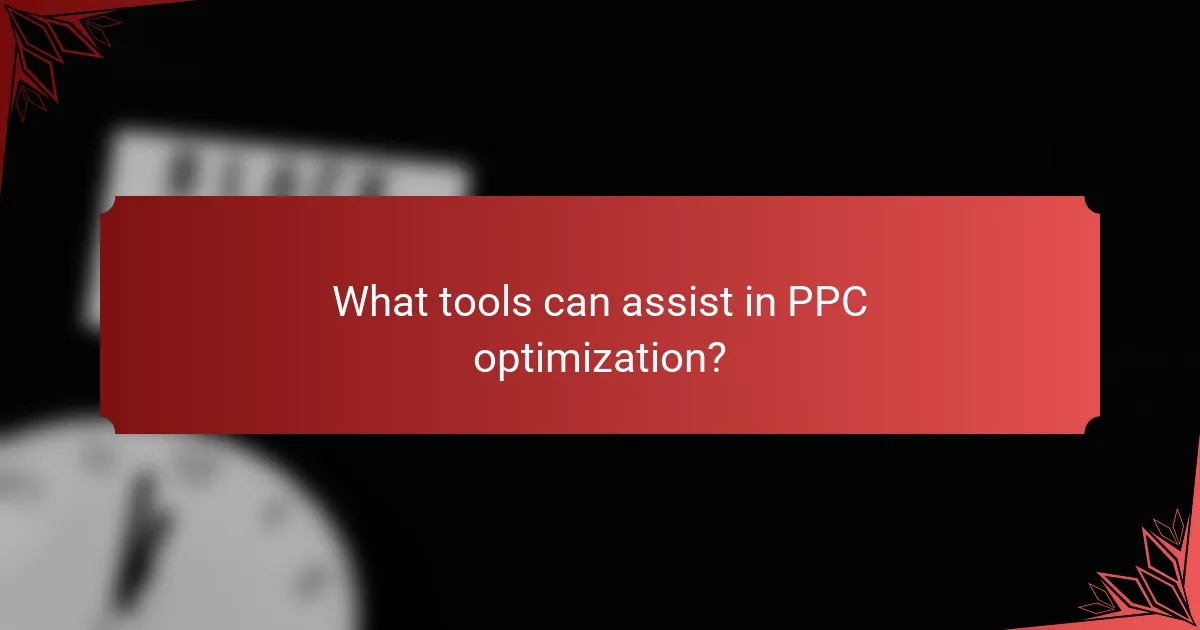
What tools can assist in PPC optimization?
Several tools can significantly enhance PPC optimization by providing insights, automating tasks, and improving overall campaign performance. Utilizing these tools effectively can lead to better keyword targeting, improved ad management, and ultimately higher conversion rates.
Google Ads tools
Google Ads offers a suite of built-in tools designed to help advertisers optimize their campaigns. Features like Keyword Planner assist in discovering new keywords and estimating their performance, while the Ad Preview and Diagnosis tool allows users to see how ads appear in search results without affecting impressions.
Additionally, the Performance Planner helps forecast campaign performance based on historical data, enabling advertisers to allocate budgets more effectively. Regularly reviewing these tools can lead to adjustments that improve click-through rates (CTR) and conversion rates.
SEMrush for keyword research
SEMrush is a powerful platform for conducting keyword research, offering insights into keyword volume, competition, and trends. By analyzing competitors’ keywords, advertisers can identify gaps and opportunities to target specific phrases that may yield higher returns.
Using SEMrush’s Keyword Magic Tool, users can generate extensive keyword lists and filter them based on various parameters. This helps in selecting the most relevant keywords for campaigns, which can enhance ad relevance and improve Quality Scores in Google Ads.
Optmyzr for campaign management
Optmyzr streamlines PPC campaign management by automating repetitive tasks and providing advanced reporting features. It offers tools for optimizing bids, managing budgets, and creating custom reports, which can save time and improve efficiency.
One notable feature is the One-Click Optimizations, which allows users to implement best practices with minimal effort. This can lead to improved campaign performance without the need for extensive manual adjustments, making it ideal for advertisers looking to maximize their ROI.
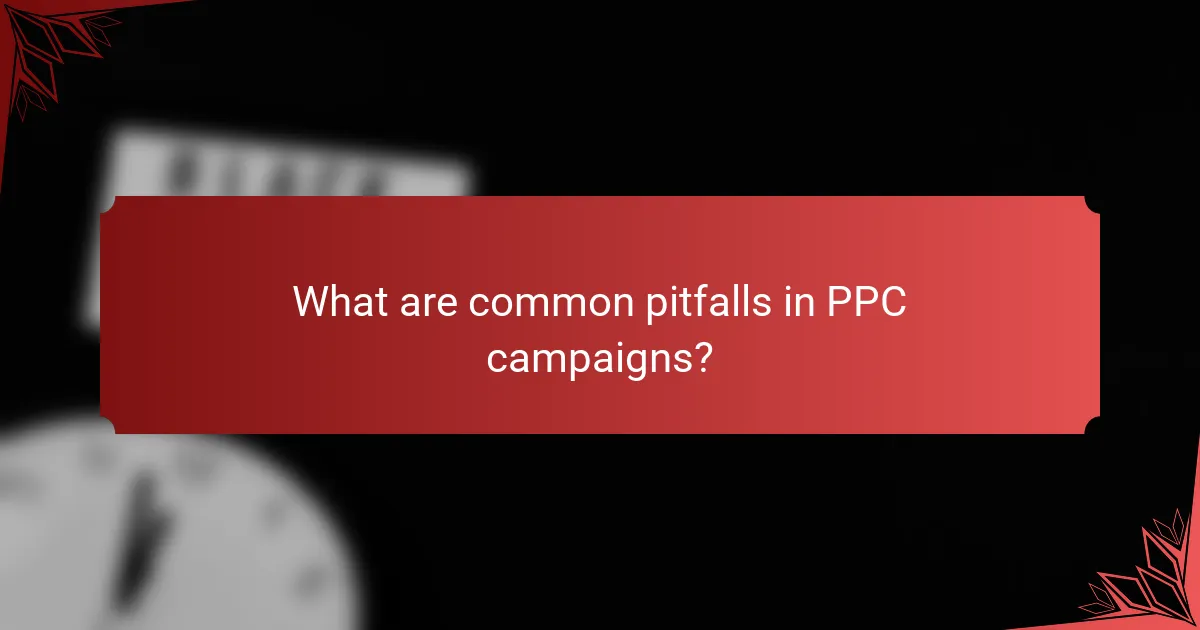
What are common pitfalls in PPC campaigns?
Common pitfalls in PPC campaigns include poor keyword selection, inadequate budget management, and neglecting ad copy optimization. These issues can lead to wasted spending and low conversion rates, ultimately affecting the return on investment (ROI).
Poor Keyword Selection
Poor keyword selection can significantly hinder the effectiveness of a PPC campaign. Choosing overly broad or irrelevant keywords may attract unqualified traffic, leading to low conversion rates. Instead, focus on long-tail keywords that are more specific and relevant to your target audience.
Conduct thorough keyword research using tools like Google Keyword Planner or SEMrush to identify high-performing keywords. Aim for a mix of high-volume and niche keywords to balance reach and relevance.
Inadequate Budget Management
Inadequate budget management can result in overspending or missed opportunities. It’s essential to set a realistic budget based on your goals and monitor it regularly. Allocate funds to high-performing campaigns while adjusting or pausing those that underperform.
Consider using daily or monthly budget caps to control spending. Regularly review your campaign performance to ensure your budget aligns with your overall marketing strategy and adjust as necessary.
Neglecting Ad Copy Optimization
Neglecting ad copy optimization can lead to low click-through rates (CTR) and poor engagement. Your ad copy should be compelling, relevant, and include a clear call to action. Test different variations of your ads to see which resonates best with your audience.
Utilize A/B testing to compare different headlines, descriptions, and display URLs. Regularly update your ad copy based on performance metrics to keep your campaigns fresh and engaging.
